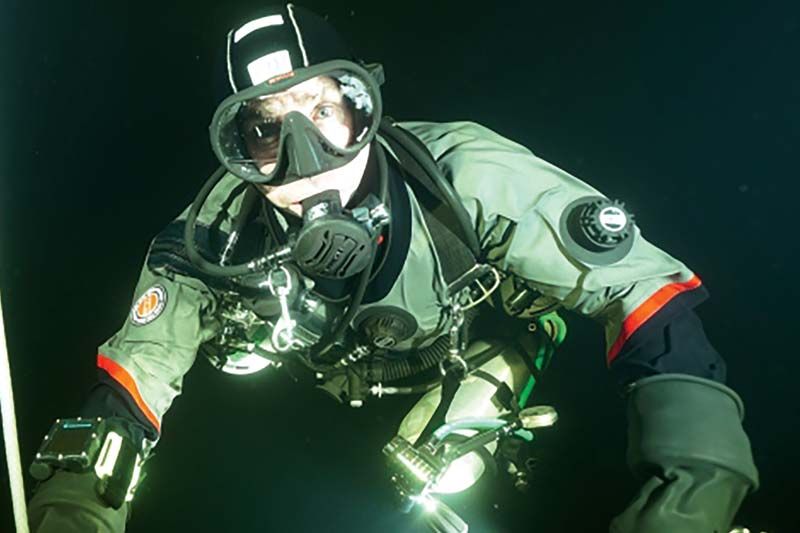Craig Bakay | Feb 07, 2018
Diver/U of Ottawa anthropology grad student Kevin Brown didn’t pick the Mazinaw for his through-the-ice dive two weekends ago specifically because as the second deepest lake in Ontario excepting the Great Lakes (Lake Timiskaming is the deepest) the chance to set a record for the deepest under the ice dive ever was a possibility.
The biggest reason was to begin a series of dives (related to his Master’s thesis) looking for indigenous artifacts in the area.
But, since he was down there . . .
The previous world record was 72 metres (236 feet). Brown doubled that with a dive of 132 metres (434 feet).
“We decided to dive there because there was a lot of traffic in the area back in the pre-colonization days,” he said. “We didn’t find any artifacts but we decided to start at the deepest spot and we’ll move a bit to the right with subsequent dives.”
By “a bit to the right,” Brown means closer to Bon Echo Rock, where 260 pictographs attributed to First Nations artists from centuries ago can be found. The location of this dive, was a bit north and west of the rock itself.
“We don’t seek record-breaking, we seek exploration,” he said. “We weren’t really expecting to find anything but then at that depth, you can only spend about eight minutes exploring the bottom.”
What he did find was about an inch to an inch and a half of “fine, volatile silt,” he said. “It was a virgin destination that looked like landing on the moon.”
The dive itself took eight minutes for the descent and two hours for the ascent. Brown had six “emergency divers” helping but the deepest any of them got was 55 metres (180 feet).
Brown used a dual rebreather system for his dive, which he estimates cost around $30,000 US and that doesn’t include the gear for his safety divers.
“I’d like to emphasize that this was very much a team effort,” he said. “It’s like the Tour de France.
“You have a lot of team members contributing to that one guy who crosses the finish line first.
“The guys did all the work.
“I was just the guy who went down there.
“And, I’d like to mention my wife, Ayesha. She was very supportive and you need a lot of moral support for something like this.”
And speaking of going to the bottom, it’s cold down there, it’s dark and given the pressure of all that water above you, it doesn’t make for the greatest of working conditions. You don’t have the greatest manual dexterity and you move slowly.
“The pressure makes it hard to breathe and my face was swollen because of the cold water and decompression,” he said.
But fear didn’t enter into it.
“Frankly, I’m more afraid of answering reporters’ questions,” he said. “But any feelings of anxiety or anything like that was pretty much gone the night before the dive.
“You can’t let emotion enter into it - you have to focus.”
He was acutely aware that he was diving under ice however, and that’s why they drop down a line. You want to make sure you know where the hole in the ice is when you get back up. But there is one distinct advantage to an ice dive. It takes some serious gear to get down that deep and being able to load it all into the back of a few pickup trucks and driving out to the dive spot meant they didn’t need a boat big enough to haul it all as well as being able to stay in the same spot for hours.
Brown acknowledges that like the first people to climb Everest, curiosity was a big driver in this project.
“You don’t need to have a mission,” he said. “But there are still a lot of questions to be answered.”
And he plans to answer as many of them as he can. He does have some First Nations blood in him (“my great grandmother was Innu,” he said) and he very much wants to find some artifacts that might answer questions as to what life was like in the area 1,500 years ago.
To that end, he’d very much like to talk to anyone that might have some tips for him as to where to look and he’d like to make contact with First Nations groups to ensure that anything he does find is “displayed properly” with respect. Anyone who might be able to help can contact Brown through his Facebook page.
More Stories
- Latest CUPW Job Action Stops Postal Delivery Of The Frontenac News Forcing Alternate Plans
- Opponents of Barbers Lake Gravel Pit Pack Ag Hall in McDonalds Corners
- Bobsleigh Olympian Jay Dearborn At Mikes Pizza In Sydenham
- The Loins Club Of and O'Lakes Roar
- North Frontenac Back Roads Studio Tour - September 27 and 28
- Sunday Market Vendors Give Back
- George Street Work As Town Hall Renovation Nears Completion
- One Way Street Plan Hits A Dead End - Central Frontenac Council, September 9
- Global Gardening
- No Winner Yet in Catch The Ace But Fundraising Target Met

